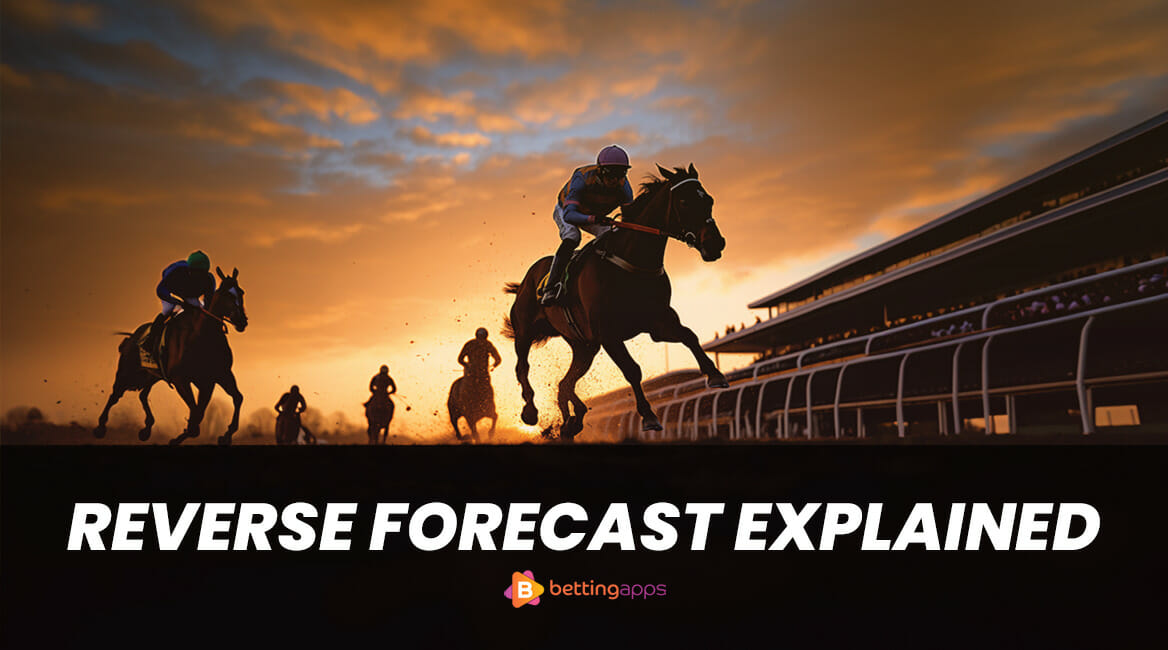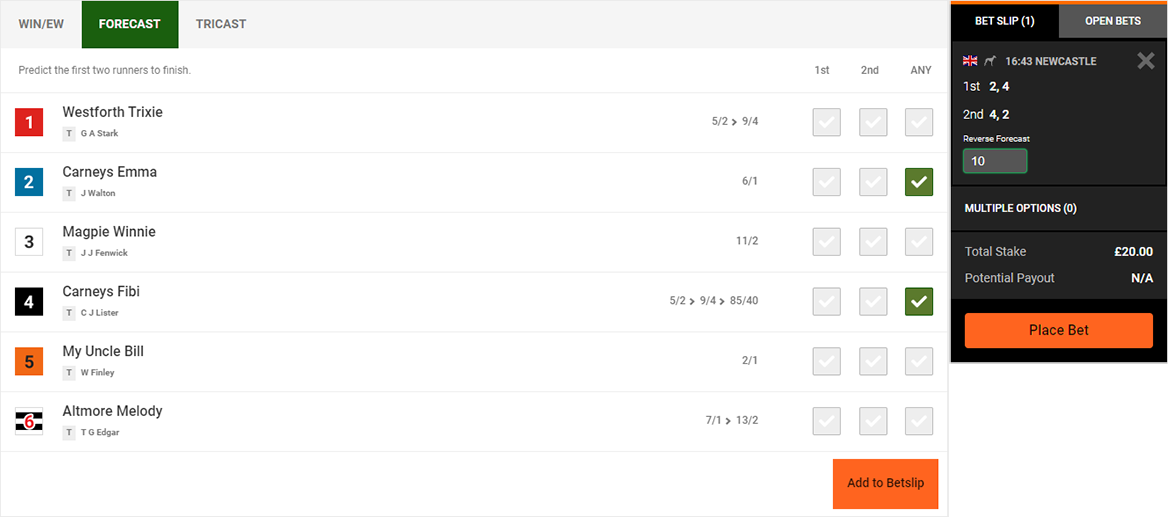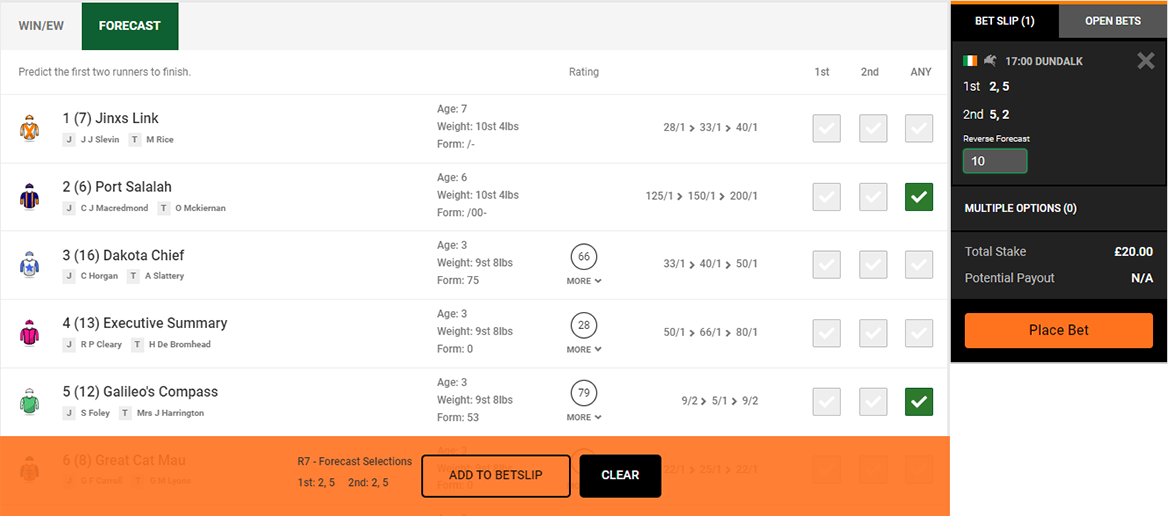What Is a Reverse Forecast Bet, And How Do You Place It?

Reverse forecast betting is perhaps one of the most profitable bets in horse and greyhound racing. There are a few different types of them, so in this article, we will explain how they work and how you can determine their cost. So, let’s get started.
So, What is a Reverse Forecast Bet?
Reverse forecast bets are popular in horse racing and greyhound racing, but you can actually use them in any event where participants can finish first and second place. For example, you can choose two dogs that you think will end up in top places, but you don’t need to specify the exact order in which they will do so. Either way will give you winnings.
Greyhound Racing Reverse Forecast Bet Example
To make things easier, let’s see an example. Suppose you’ve picked Greyhound 2 and Greyhound 4 for a race. You’re not sure which dog will do better because, for instance, they finished pretty close the last time you saw them. Instead of taking a straight forecast, you can instead place a reverse forecast bet, so you will be a winner even when:
- Greyhound 2 finishes first place, and Greyhound 4 finishes second place.
- Greyhound 4 finishes first place, and Greyhound 2 finishes second place.
 Example of the bet reverse forecast bet selection
Example of the bet reverse forecast bet selection
Of course, betting on two different forecasts is more expensive than doing so on just one. In practice, what you’re doing is making two bets on one (for Greyhound 2 to win and Greyhound 4 to be second, and for Greyhound 4 to win and Greyhound 2 to be second).
Horse Racing Step-by-Step Reverse Forecast Example
In this example we are selecting horse 2 (Port Salalah) and horse 5 (Galileo’s Compass) for a race that happened at Dundalk. Similar to the first example, we are uncertain of who will place 1st and who will place 2nd. So we select “Any” on for both when selecting them for the forecast, which adds a reverse forecast to the betslip. This type of forecast bet means you will win even when:
- Horse 2 (Port Salalah) finishes 1st, and Horse 5 (Galileo’s Compass) finishes 2nd.
- Horse 5 (Galileo’s Compass) finishes 1st, and Horse 2 (Port Salalah) finishes 2nd.
 Example of the horse racing bet selections for a reverse forecast.
Example of the horse racing bet selections for a reverse forecast.
Reverse Forecast, Straight Forecast, Combination Forecast, and Tricast Bets
We mentioned that you can do reverse forecast betting on any event that has a finishing order. The same applies to straight and combination bets, but there are, of course, some differences.
A straight forecast (also referred to as simply a forecast) allows you to pick two selections and choose the order in which you think they will finish. For example, Greyhound 1 finishes first place, and Greyhound 3 finishes second place. Your wager will only be a winning one if the dogs finish in that precise order.
We have gone through a reverse forecast, so we know that the order of the two dogs doesn’t matter as long as they both finish in the first two places.
There are, however, two more options: A combination forecast and a tricast bet.
Combination Forecast Bet
If you think there are three dogs that have a good chance of finishing first, you can do a combination forecast consisting of six separate bets. For example, for the picks Greyhound 1, Greyhound 3, and Greyhound 5, you would place 1/3, 1/5, 3/1, 3/5, 5/1, and 5/3. If you want to bet on four dogs, you would need 12 bets, five dogs 20 bets, and so on.
Tricast Bet
In a tricast bet, you pick three dogs, and you try to predict their finishing order for the top three places. This is a good idea if you have a good feeling about three specific contestants. For example, you can choose Greyhound 1 to finish first, Greyhound 3 to finish second, and Greyhound 5 to finish third.
There is also a reverse tricast option, where you can pick three dogs to finish in any order in the top three spots. In this case, you would place 6 separate bets: 1/5/3, 1/3/5, 5/1/3, 5/3/1, 3/1/5, and 3/5/1.
How to Place a Reverse Forecast Bet
There are many betting sites that support reverse forecast betting, including Ladbrokes, Paddy Power, William Hill, and bet365. For most of them, you will need to locate the forecast tab, navigate to reverse forecast odds and pick the dogs or horses you think will finish in the first two spots.
Many bookies include fixed-price reverse forecasts that show the odds and potential returns. However, greyhound racing might instead use something called the Computer Straight Forecast (CSF) – a computer calculation that can help you work out your payout depending on the runners and their SPs (or Starting Prices).
Using a Reverse Forecast Calculator
A reverse forecast calculator is a great tool for calculating the potential payouts for reverse forecast betting.
The way they work is quite straightforward: You input the odds of the selected greyhounds and the stake amount, and you can determine the potential returns if your chosen dogs finish in the top two positions (this is done regardless of the order).
There are many bookmakers that offer their own reverse forecast calculators. For example, Unibet has an easy-to-use one that lets you pick single, double, and treble for both straight forecast and reverse forecast.
The calculation is based on multiple factors. For example, the number of dogs that are involved in the race, their respective odds, and others. By using a calculator, you can assess the potential returns and make better-informed decisions when you place your straight forecast or reverse forecast bets. Keep in mind, though, that these numbers should be used for informational purposes only, as the actual payouts will depend on the specific rules and policies of the bookmaker.
Reverse Forecast Bets: Conclusion
Making a reverse forecast bet for horse and greyhound racing is very straightforward. Most bookmakers use betting slip screens where you can pick the horse or dog and choose between selections like a straight forecast bet or a reverse forecast bet (as well as combinations and tricasts).
Depending on your budget and betting style, you can calculate your costs and go for smaller or larger stakes. As we have covered above, it’s always a good idea to use a calculator, so you can get a good idea of the returns you can get on your picks.
